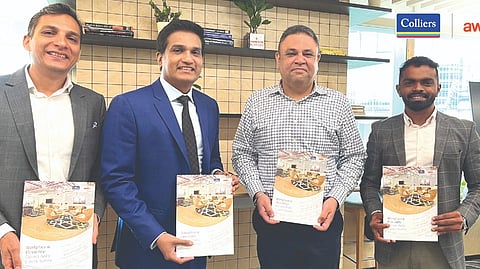

Over the last two years, offices have not only survived the pandemic, but are being reimagined to be more cutting-edge as its very purpose is evolving. The pandemic has led occupiers to look at the bigger picture. What do they want from offices? What is the purpose of an office? How can they offer better work-life balance? What works best for their business goals? While some occupiers have gone ahead and formulated hybrid work styles in varying degrees, others continue to strategise their workplace plans. But, one aspect is for sure – Workplaces are now viewed more as essential places for employees to come together for much-needed bonding.
Offices are no more just a space for ‘all work and no play’ but are places which foster collaboration, innovation and wellbeing of the employees. A sense of belongingness, enabling casual and chance interactions, team bonding and greater collaboration – a workplace now exists in various forms and serves various purposes, notes Ramesh Nair, CEO, India & MD, Market Development, Asia Colliers.
To understand how occupiers are reimagining their future workplaces, Colliers and flex space operator Awfis conducted a survey with CXOs to understand their strategies regarding distributed workplaces and role of flex spaces.
Occupiers are looking for a workplace model that not only furthers their business goals, but also creates a comfortable working environment for the employees. Employee wellness has now become an integral part of real estate decision-making for occupiers. Occupiers are paying heed to aspects such as work-life balance and the mental well-being of employees. As occupiers weave in employees’ well-being along with furthering business goals, we see an overarching theme of distributed workplaces in their plans.
A distributed workplace can be in several forms – mix of flex spaces and traditional office in the same city; multi-offices in the same city `ala a hub and spoke model; a mix of flex space and traditional offices across tier I and tier II cities - No one size fits all. The approach towards distributed workplaces is now propelling the growth of flex spaces in metro cities, with flex operators also making inroads into tier II cities. Flex operators have already leased 3.5 million sq feet of office space during H1 2022 in the top six cities, about 73 per cent of the space leased in full year in 2021.
In tier II cities, flex spaces are likely to grow more than two-fold to 5.5 million sq feet by the end of 2022. Will this bull-run continue over the next few years? Time will tell, but the need for flexibility in leases and a purpose-led workplace will continue to be a priority for occupiers, Nair added.
In the new normal, offices are becoming places for collaboration and brainstorming, rather than simply workspaces, and flex spaces are expected to cater to the changing demands in this evolving landscape. Office space absorption across top Indian cities is on path of recovery, as per Workplace & Flexibility: Colliers Awfis C-suite Survey.
Occupiers are leasing spaces for building next-generation offices. At the same time, occupiers are exploring distributed workspace strategy, by optimising employees’ needs, while prioritising business needs. As many as 79% of the occupiers feel distributed workplace strategy will be highly beneficial to save time and cost while 33% of the total occupiers who believe that distributed workplace strategy helps save time and costs are from IT/ITeS sector, the survey reveals.
Clearly, benefits to employees is at the core of occupiers’ interest. The pandemic has nudged occupiers to be more employee-centric, while not letting go of productivity gains. Employee satisfaction and retention is becoming even more critical, especially in the era of ‘the great resignation.’
Occupiers believe a distributed work model in next-generation offices will help in enhancing employee morale.
Visit news.dtnext.in to explore our interactive epaper!
Download the DT Next app for more exciting features!
Click here for iOS
Click here for Android